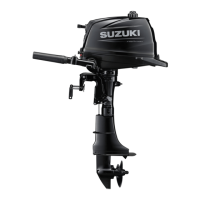39
OPERATION IN SALT WATER
After operating the motor in salt water, you
should flush the water passages with clean,
fresh water as outlined in the FLUSHING THE
WATER PASSAGES section. If you do not flush
the water passages, salt can corrode the motor
and shorten its life.
WARNING
When the shallow water position is used,
the tilt lock will not work. As a result,
forces such as from propeller thrust dur-
ing operation in “REVERSE” gear, rapid
deceleration, and striking an underwater
object can cause the motor to lift out of
the water, resulting in personal injury.
When using the shallow water position,
proceed with caution and only at very low
speeds.
NOTICE
If you do not take proper precautions
when operating your boat in shallow
water, your outboard motor or boat could
be damaged.
• When you operate your motor in shal-
low water using the shallow water posi-
tion, make sure that the water intake
holes remain in the water at all times
and that water is always spraying out of
the water discharge hole.
• Do not allow your motor to hit bottom,
particularly when operating in
“REVERSE” gear, or serious damage
can result. When the motor hits bottom
while operating in “REVERSE” gear,
the shock acts directly on the transom,
and both the motor and the boat could
be damaged.
OPERATION IN FREEZING WEATHER
When operating your outboard motor in freez-
ing temperatures, you should keep the lower
unit submerged in the water at all times.
When taking motor out of the water, stand it up
in a vertical position until the cooling system
drains completely.
NOTICE
If you leave your outboard motor out of
the water in freezing temperatures with
water still in the cooling system, the
water can freeze and expand, causing
severe damage to the motor.
When your outboard is in the water in
freezing temperatures, keep the lower
unit submerged in the water at all times.
When the motor is stored out of the water
in freezing temperatures stand it up in the
vertical position so that the cooling sys-
tem drains completely.

